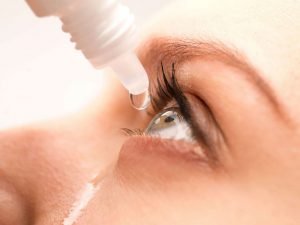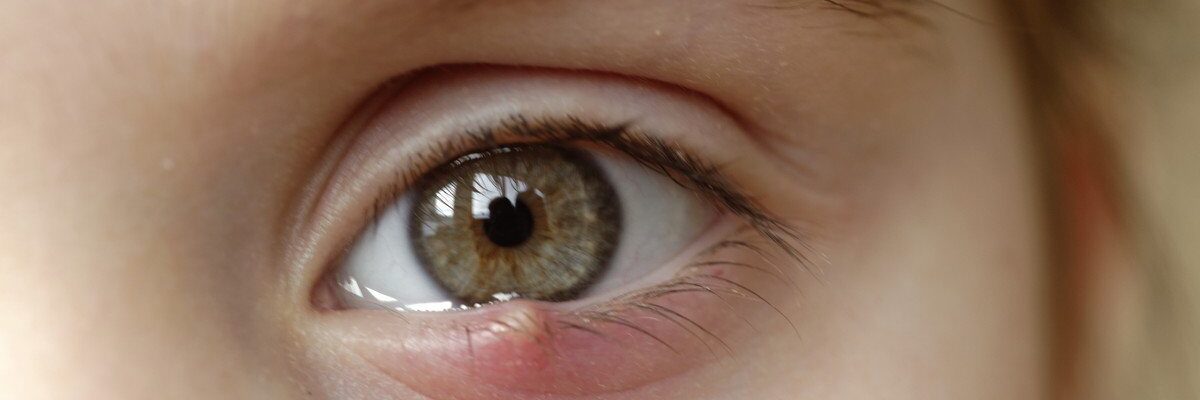Overview
A stye, also known as hordeolum, is a common and usually harmless condition that appears as a small, red, and often painful bump on the edge of the eyelid. It occurs when oil glands or hair follicles at the base of the eyelashes become infected, often due to the bacterium Staphylococcus aureus. While styes are not contagious, poor hygiene or rubbing the eyes can increase the risk of developing one.
The effects of a stye can include localized pain, swelling, and tenderness in the affected area. The eyelid may feel heavy or irritated, and in some cases, the eye can water excessively. Occasionally, a stye can grow large enough to obstruct vision or cause discomfort when blinking. Despite these symptoms, styes rarely pose a serious threat to eye health and typically resolve on their own within a week.
Treatment for a stye is generally straightforward and focuses on relieving symptoms. Applying warm compresses to the affected area several times a day helps to soften the blockage and promote drainage of the pus. Over-the-counter pain relievers or antibiotic ointments may be used in some cases to reduce discomfort or fight the infection. In severe instances or when a stye persists, a doctor may perform a minor procedure to drain it.
Prevention plays a key role in avoiding styes. Maintaining good eyelid hygiene, such as removing makeup thoroughly and avoiding touching or rubbing the eyes, can significantly reduce the likelihood of infection. Regularly cleaning contact lenses and avoiding the sharing of eye cosmetics are also essential preventive measures. By adhering to these practices, individuals can minimize their risk of experiencing this irritating condition.
Table of Contents
When to See a Doctor
While most styes resolve on their own with simple home care, there are instances where it is important to consult a medical professional. Ignoring more serious symptoms could lead to complications or prolonged discomfort. Seeking medical attention ensures proper diagnosis and treatment for unusual or severe cases.
Signs to see a doctor:
- The stye persists for more than a week. If the swelling does not subside or the stye remains painful after a week of home treatment, it may require professional evaluation.
- The swelling spreads beyond the eyelid. If the redness or swelling extends to other parts of the face or around the eye, it could indicate a more serious infection, such as cellulitis, that needs immediate medical intervention.
- Vision becomes impaired. Blurred or obstructed vision due to the size or location of the stye should not be ignored and warrants a visit to a healthcare provider.
- Multiple styes or frequent recurrence. If a person develops multiple styes at once or experiences frequent styes over a short period, it may point to an underlying condition, such as blepharitis or a systemic health issue, requiring a doctor’s attention.
- The stye becomes unusually large or increasingly painful. These symptoms may suggest the presence of a chalazion, a deeper and potentially more serious condition that might require medical drainage or further treatment.
- Discharge of yellow or green pus occurs. This could signal a severe bacterial infection that requires prescription antibiotics to prevent further complications.
- The eyelid appears significantly misshapen or deformed. Structural changes to the eyelid could be a sign of a more complicated issue and should be assessed promptly.
While many styes are manageable at home, timely medical consultation for the above scenarios can prevent complications and ensure faster relief. A healthcare provider can also provide tailored advice or perform minor procedures if necessary, aiding in quicker recovery.
What Type of Doctor to Seek
When dealing with a stye that requires medical attention, it is best to consult an ophthalmologist or an optometrist. Ophthalmologists are medical doctors specializing in eye health, capable of diagnosing and treating styes as well as other related conditions. They are equipped to perform minor surgical procedures, such as draining a large or persistent stye, and can prescribe medications like antibiotics or anti-inflammatory eye drops when needed. Optometrists, while not medical doctors, are trained to assess and manage many eye-related conditions, including styes, and can provide appropriate treatment or refer patients to an ophthalmologist if specialized care is necessary.
In some cases, a visit to a general practitioner or family doctor may suffice, especially if the symptoms suggest a minor infection or if an immediate referral to an eye specialist is needed. However, if the stye is accompanied by significant pain, impaired vision, or other serious symptoms, seeking the expertise of an ophthalmologist is recommended to ensure thorough evaluation and treatment. These specialists are best equipped to address complications or determine if another underlying condition is contributing to the problem.
What to Expect from Your Visit to a Doctor
When visiting a doctor for a stye, the initial step will typically involve a thorough examination of your eye and eyelid. The doctor will assess the stye’s size, location, and severity, as well as check for any signs of spreading infection or underlying conditions like blepharitis or meibomian gland dysfunction. They may ask questions about your symptoms, such as the duration of the stye, pain level, and whether it has affected your vision. For recurrent or unusual cases, they may inquire about your overall health and hygiene habits to identify any contributing factors.
Depending on the findings, the doctor may recommend a treatment plan tailored to your condition. This could include prescription antibiotic ointments or drops, oral antibiotics for more severe infections, or a minor procedure to drain the stye if it is particularly large or persistent. In this procedure, the area will be numbed, and a small incision made to allow the stye to drain. For chronic or recurrent styes, the doctor might suggest further tests to rule out underlying issues and provide guidance on preventive measures. Most treatments are quick and effective, offering relief and preventing complications.
Stye Treatment Options

A stye, or hordeolum, often resolves on its own without the need for medical treatment. Most styes naturally burst and begin to heal within 3 to 4 days. However, there are several steps that can be taken to alleviate discomfort, reduce swelling, and address other symptoms associated with the condition. Here are some of the most effective treatment options:
- Cleaning the eyes. To prevent dirt and pus buildup in the affected area, clean the eyes using a gentle soap and water. Ensure that the soap used is mild, such as baby soap, to avoid further irritation to the eyes.
- Applying a warm compress. Using a warm compress helps the stye mature and encourages it to drain naturally. This method also eases pain and reduces swelling. To do this, soak a clean, soft cloth in warm water, wring out the excess, and place it over the affected area for 5 to 10 minutes. Repeat this process 3 to 4 times a day. Avoid forcefully popping the stye; let it drain naturally.
- Using a warm tea bag. A warm tea bag can double as a compress, and its antibacterial properties may help fight the infection. To use, steep a tea bag in hot water for about a minute, then remove and let it cool to a warm, comfortable temperature. Place the tea bag on the stye for 5 to 10 minutes.
- Gently massaging the eyelid. Massaging the area can help drain the pus from the stye. Be sure to wash your hands thoroughly before doing this. Using a clean wipe during the massage can also help capture any pus that drains out.
- Removing obstructing eyelashes. For external styes located near the edge of the eyelid, a blocked eyelash may need to be removed. This is typically done using clean tweezers, but it may be painful, as the eyelash is being pulled from an inflamed area.
- Using antibiotics. If the infection is severe, a doctor may prescribe antibiotic eye drops, creams, or even oral antibiotics for more systemic treatment. These medications help combat the infection and prevent it from worsening.
- Taking pain relievers. Over-the-counter pain relievers like paracetamol or ibuprofen can help alleviate significant pain or discomfort caused by the stye.
- Steroid injections. In some cases, a doctor may recommend a steroid injection to reduce inflammation and pain. This is typically reserved for severe or recurrent styes.
If a stye becomes severe or particularly large, more invasive treatments may be required:
- Incision and drainage for external styes. In this procedure, a doctor uses a small scalpel to make an incision in the stye to allow pus to drain. This method is typically performed for styes on the outer edge of the eyelid.
- Drainage for internal styes. For styes located inside the eyelid, the doctor will administer a local anesthetic, flip the eyelid to expose the stye, and make an incision to drain the pus. Antibiotic eye drops are often prescribed afterward to prevent infection and promote healing.
During recovery, it is advised to avoid wearing makeup or contact lenses, as these can worsen irritation or prolong healing. Opt for glasses instead of contact lenses to reduce the risk of reinfection.
If the stye grows larger, becomes increasingly painful, or affects vision, it is crucial to consult a doctor. Persistent or severe symptoms may indicate underlying conditions such as conjunctivitis, blepharitis, or cellulitis, requiring professional evaluation and treatment.
Stye Prognosis
The prognosis for stye treatment options is generally favorable, with most cases resolving within a few days to a week, depending on the method used. While many treatments focus on symptom relief and promoting natural healing, some address more severe or persistent cases. Here’s an overview of what to expect with each treatment option:
- Cleaning the eyes. Regular eye hygiene helps prevent further irritation or infection. For most mild styes, this simple step supports healing within a few days.
- Applying a warm compress. This method often speeds up the maturation and drainage of the stye, with relief typically observed within 3 to 4 days.
- Using a warm tea bag. The antibacterial properties of tea, combined with heat, may reduce infection risk and encourage healing, with similar timelines to warm compresses.
- Gently massaging the eyelid. Proper massage can promote pus drainage and symptom relief, often aiding resolution within a few days when combined with warm compresses.
- Removing obstructing eyelashes. When performed correctly, this can provide immediate relief by clearing the blockage. Healing generally follows a natural course over the next few days.
- Using antibiotics. For severe or infected styes, antibiotics can reduce symptoms within 24 to 48 hours and prevent further complications. Full recovery may take a week.
- Taking pain relievers. While these do not directly treat the stye, they effectively reduce discomfort, making the healing process more manageable.
- Steroid injections. Inflammation and pain typically subside within a few days after the injection, with noticeable improvement in swelling.
- Incision and drainage. Immediate relief is often achieved after this procedure, though the eyelid may take a few days to a week to fully heal. Antibiotics may be prescribed to ensure smooth recovery.
- Drainage for internal styes. Similar to external drainage, relief is usually quick, with additional antibiotic treatment ensuring no complications arise during recovery.
Most styes resolve completely with appropriate care, and complications are rare when treatment is timely and effective. Adhering to preventive measures and following through with recommended treatments ensures minimal disruption to daily life and quick recovery.


